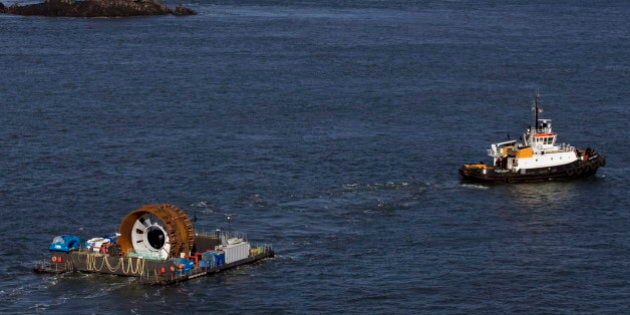
The first electrons of power flowed across the seabed in Nova Scotia's Minas Basin recently delivering electricity to homes, from a giant instream tidal device. It's planned to be the first of many such devices, covering multiple designs and arrays, to see if tidal energy can be made cost effective and safe. I hope it works. I want to be excited about it. Happy even.
Instead, it's tainted by the dismissive attitude of Nova Scotia's government towards indigenous people and fishers, or really anyone in the province who raises concerns about the potential impact on their lives from these experiments.
Most of those raising concerns aren't opposed to the development of instream tidal energy in the province. They just want it done right, with science based monitoring, and their questions answered. It doesn't seem unreasonable.
I first worked on tidal energy research in 1991. Since then I've often found myself working on tidal and other energy projects. In early 2014, as Nova Scotia's energy minister I prioritized tidal energy development. I successfully got cabinet approval for money to connect instream projects to the grid.
Nova Scotia's Mi'kmaq have raised concerns about fish habitat and lack of meaningful inclusion of traditional indigenous knowledge.
The benefit for Nova Scotians, as I saw it, was primarily in the research and engineering opportunities. Nova Scotia didn't need the energy itself, construction jobs would be short term as turbines would always be built close to the installation location due to their size, and while export opportunities existed, they would require significant transmission upgrades paid by someone other than Nova Scotia ratepayers. But the opportunity to create a research and engineering center of excellence is almost unlimited, and offers the chance to spin off into other industries over time (Nova Scotia's own space program if you will).

Andrew Younger (right) signing an agreement on tidal energy research with British Deputy High Commissioner for Canada, Corin Robertson, and Offshore Research Association Executive Director Stephen Dempsey - Photo courtesy Communications NS.
This should be the exciting time I want it to be and in many respects it is. But with one turbine in the water, fishers and indigenous communities are correct that the opportunity already suffers from a lack of baseline research undermining the basis of credible science.
In 2014 I led a trade mission to Europe to discuss the cooperative development of tidal energy. In both Scotland and Ireland one thing was clear, you don't move ahead with ocean energy projects without having the cooperation, participation, and understanding of the existing resource users. At meetings with developers, researchers, government, and other stakeholders one thing was made clear -- the success of ocean energy projects requires working with groups like fishers and indigenous communities, not ignoring them.
Yet, in Nova Scotia a growing chorus of people are raising concerns that their questions have gone unanswered. That they have been shut out of participation and discussions. In some cases developers have not even showed up to meetings. Nova Scotia's Mi'kmaq have raised concerns about fish habitat and lack of meaningful inclusion of traditional indigenous knowledge.
The Chief of the Annapolis Valley First Nation says Mi'kmaq concerns are not being listened to and that Mi'kmaq understand why others also have concerns. Ignoring the Mi'kmaq in the deployment of these projects is ever more concerning given the Nova Scotia government's recent claim in a court proceeding related to a different energy project that at least some Mi'kmaq are a "conquered people," and therefore not entitled to consultation.
Despite concerns, Nova Scotia's Energy Department has largely ignored those who have raised questions. They respond that tidal devices have been installed elsewhere in the world without incident.
The problem is that statement is at best misleading, and at worst, a lie.
When I was minister, I removed that claim from department communications. Now it has returned. This goes to the heart of the government's credibility because they know it's misleading. Most of the sites where demonstration tidal devices have been installed around the world are channels, not funnel shaped bays like Nova Scotia's site.
Tidal energy, and ocean energy generally, could have amazing potential for Nova Scotia, Canada, and the world.
The reason the Bay of Fundy area is so attractive for tidal development is for the very reason that it is like no other site in the world. The tidal turbines are bigger, the power of the water stronger, and the potential greater. The fishing opportunities are richer and biodiversity more, well, diverse. So it's meaningless that there have been no incidents in the few installations elsewhere.
This is why complete baseline environmental studies (which were not done) are so important. How do you know if there is an impact if you don't know what the conditions were before installation? How do you know what conflict occur if you don't have a credible and broadly accepted way to monitor conditions under the ocean surface?
Corporate social responsibility, social license, public engagement. These are all supposed to be top tier conditions in the development of energy projects. While to some extent these have become buzzwords, their importance to the social and economic success of energy projects in this time of polarized confrontation on every project cannot be underestimated. Despite that, we see them sidelined as after thoughts time and time again.
Tidal energy, and ocean energy generally, could have amazing potential for Nova Scotia, Canada, and the world. As we move faster towards low carbon energy sources I truly hope it succeeds. Energy cost for ocean energy, which is currently many times the average cost of production (even in high cost Nova Scotia) will need to come down significantly. Efficiency will need to greatly improve.
It's not inconceivable to consider 300 or more devices in the Bay of Fundy one day. Beyond engineering and cost successes, that can only happen if industry and, especially government, stop ignoring their responsibility to fully engage and partner with stakeholders such as fishers and indigenous communities.
Read more about my views on politics and the issues of the day on my website.
Follow HuffPost Canada Blogs on Facebook
Also on HuffPost:
